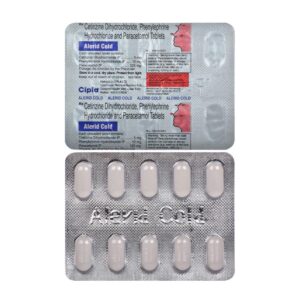PARACETAMOL + PHENYLPROPANOLAMINE + CETIRIZINE
Paracetamol: Paracetamol, also known as acetaminophen, is a commonly used medication for pain relief and fever reduction. It is classified as a mild analgesic (painkiller) and antipyretic (fever reducer).
Paracetamol’s mechanism of action is not fully understood, but it is thought to work by inhibiting the synthesis of prostaglandins in the central nervous system, which are chemicals that contribute to pain and fever. Paracetamol primarily acts on the COX-2 enzyme pathway, which is involved in inflammation and fever, but it has limited effects on the COX-1 pathway, which protects the stomach lining.
This drug is frequently used to treat mild to moderate pain such as headaches, toothaches, muscle aches, and menstrual cramps. It is also commonly used to reduce fever caused by infections, such as the common cold or flu.
The standard adult dose of paracetamol is 500-1000 mg (usually one to two tablets) every 4-6 hours, with a maximum daily dose of 4,000 mg. It is important not to exceed the recommended dose, as excessive intake can lead to liver damage. The pediatric dose varies based on the child’s weight and age.
While paracetamol is generally considered safe when used as directed, it can have side effects in some individuals. Common side effects include nausea, stomach pain, and skin rash. Rare but serious side effects, such as allergic reactions or liver damage, can occur if higher doses are taken or if the drug is used for an extended period. It is crucial to seek medical attention immediately if any signs of liver damage, such as yellowing of the skin or eyes, dark urine, or abdominal pain, occur.
It is important to note that paracetamol can be found in many combination medications, such as cold and flu remedies or pain relief formulations. Care should be taken to avoid unintentionally exceeding the recommended dose by combining multiple products containing paracetamol. It is advisable to read the labels of all medications carefully and consult a healthcare professional if unsure.
Phenylpropanolamine: Phenylpropanolamine (PPA) is a sympathomimetic drug that was commonly used as a decongestant and appetite suppressant. However, it has been withdrawn from the market in several countries due to concerns about its safety.
PPA works by stimulating the release of norepinephrine, a neurotransmitter, which causes vasoconstriction and reduces swelling in the nasal passages, thereby relieving congestion. It also acts on the central nervous system to suppress appetite, leading to weight loss.
Initially, PPA was available in oral tablets or liquid formulations. The typical recommended dose for nasal congestion was 25-75 mg every 4-6 hours, while for appetite suppression, the recommended dose was 25-75 mg once daily.
However, the use of PPA has been associated with serious side effects, including an increased risk of hemorrhagic stroke (bleeding in the brain), especially in women. Other possible side effects include increased blood pressure, heart palpitations, insomnia, nervousness, tremors, and dizziness. PPA should not be used by individuals with high blood pressure, heart disease, diabetes, thyroid problems, or certain psychiatric conditions.
Due to the risks associated with PPA, it is no longer available as a prescription or over-the-counter medication in many countries. It is important to consult with a healthcare professional for safe and appropriate alternatives for decongestion or appetite suppression.
Cetirizine: Cetirizine is an antihistamine medication used to relieve allergy symptoms such as sneezing, itching, watery eyes, and runny nose. It is commonly used for the treatment of hay fever (allergic rhinitis), hives (urticaria), and other allergic reactions.
The mechanism of action of cetirizine involves blocking the effects of histamine, a substance produced by the body when experiencing an allergic reaction. By blocking the histamine receptors, cetirizine helps reduce the symptoms caused by histamine release, providing relief from allergies.
Cetirizine is usually taken orally as a tablet or syrup. The recommended dose for adults and children above the age of 6 is usually 10 mg once daily. For children between the ages of 2-5, the dose is typically 2.5 mg in the form of a syrup or chewable tablet.
While cetirizine is generally well-tolerated, it may cause some side effects in certain individuals. Common side effects include drowsiness, dry mouth, headache, stomach pain, and dizziness. These side effects are typically mild and temporary. However, if any severe or persistent side effects occur, it is advisable to consult a healthcare professional.
It is important to note that cetirizine may interact with other medications, so it is essential to inform your healthcare provider about any other drugs you are taking. It is also important to follow the prescribed dosage and not exceed it, as doing so may increase the risk of side effects.
Overall, cetirizine is a widely used antihistamine medication that effectively relieves allergy symptoms. However, it is best to consult a healthcare professional for personalized advice and guidance before starting the medication.

